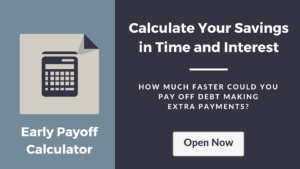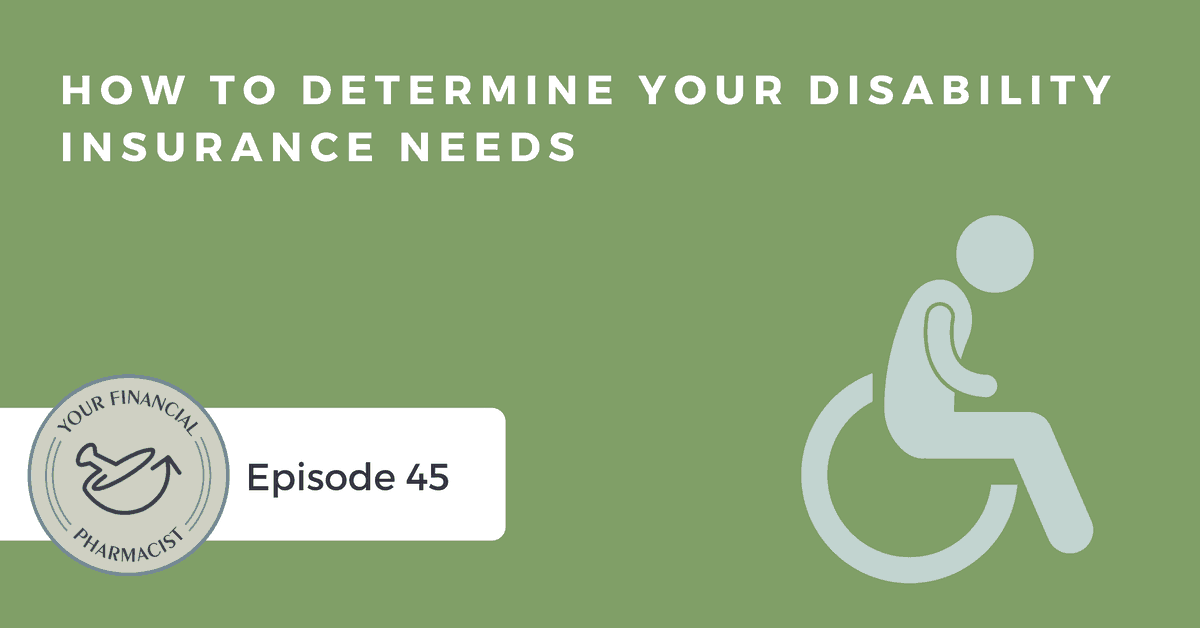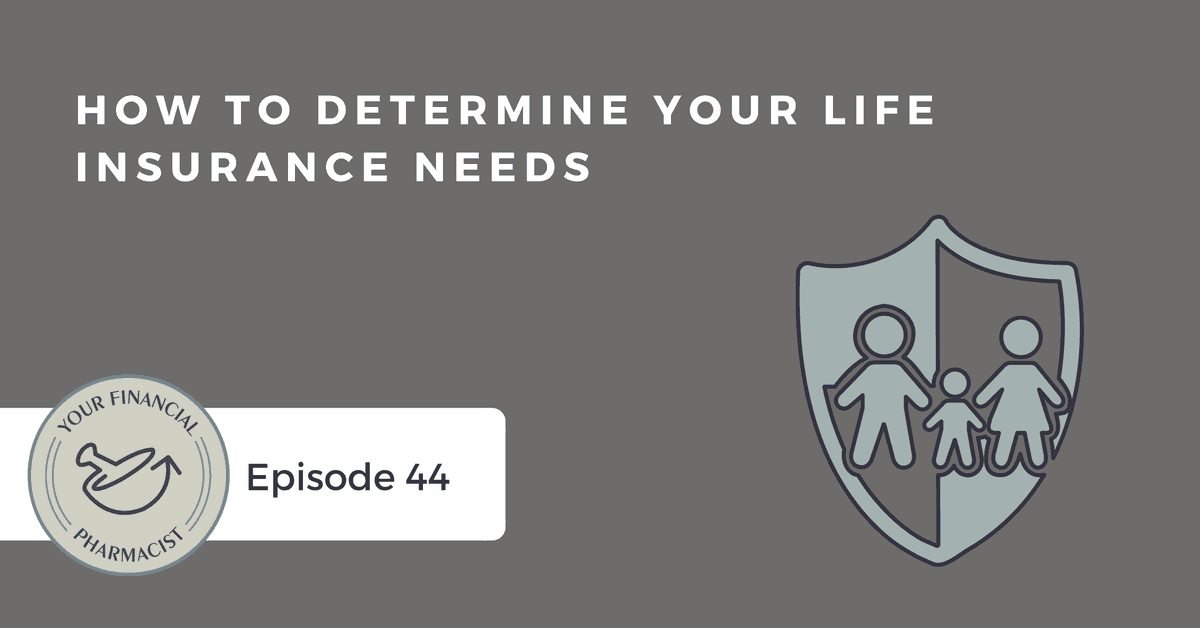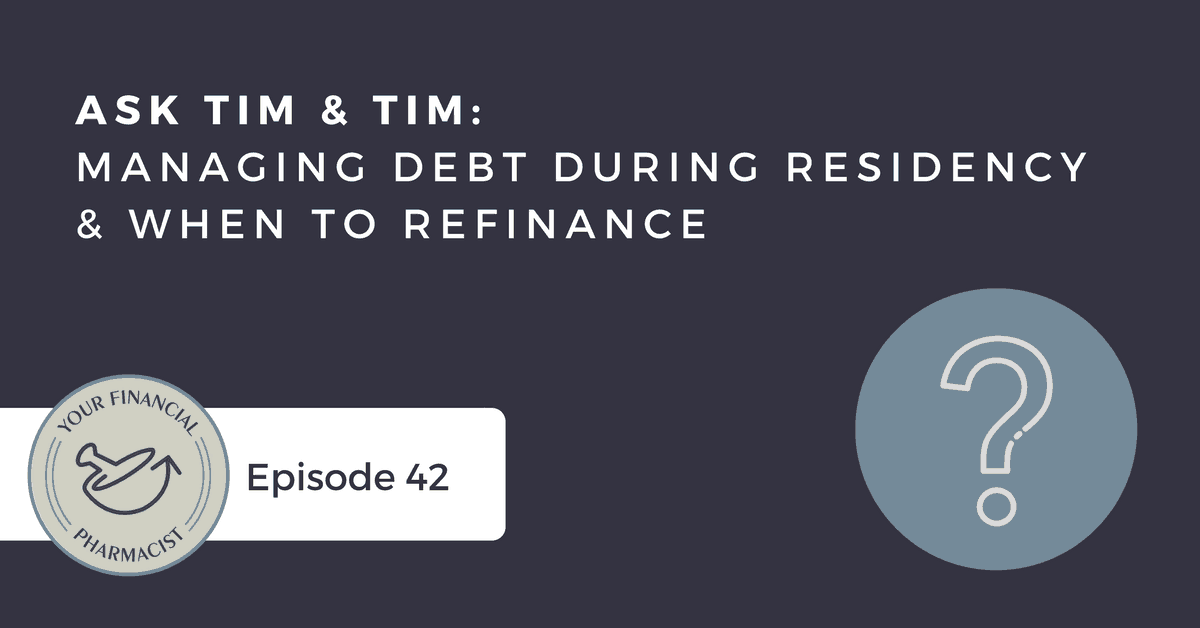On Episode 46 of the Your Financial Pharmacist Podcast, YFP team members Tim Church, PharmD, BCACP, CDE and Tim Ulbrich, PharmD tackle the most common mistakes that pharmacists make with their student loans. Whether you are a student pharmacist or a practitioner in active repayment, this episode will help you avoid the common pitfalls surrounding student loan repayment.
Episode Transcript
Tim Ulbrich: Hey, what’s up, everybody? Welcome to Episode 046 of the Your Financial Pharmacist podcast. Excited to be here alongside Tim Church to talk about common mistakes that pharmacists make with their student loans. So Tim Church, not that we would have any experience when it comes to student loan mistakes, right?
Tim Church: Oh, not at all. I did everything, executed it perfectly and right on the right path. No, actually, it was funny when I was thinking about this episode. And we talk about common mistakes that pharmacists make. Really, it’s the five mistakes that Tim Church made. I mean, we could have made that the name of it.
Tim Ulbrich: Seriously, it brings me back to when you and I were writing the “Seven Figure Pharmacist,” and we wrote all that student loan content and much of the other content based on the mistakes that we made. But I had, actually, the pleasure this weekend to go to Mercer University in Atlanta, Georgia, and talk with a group of their graduating students about personal finance and transitioning to new practitioner life. And as I was going through the section on student loans and had a chance to share from the mistakes that I’ve made and all the wisdom that you’ve shared and the YFP community has shared, all I could think was, man, I wish I would have had this information, right? When we graduated. Wouldn’t that have been nice?
Tim Church: That would have been great. There’s so many things I wish I could go back and do because I would have saved a ton of money in interest and just the amount I’m going to pay over the life of my loans.
Tim Ulbrich: And stress, right?
Tim Church: Yeah, definitely.
Tim Ulbrich: So where are you — quickly — where are you at in the journey of the payoff? So the Church household, where are you guys at?
Tim Church: So me personally, I have about $8,000 left. My wife, she’s got substantially more. But we’re looking at probably within a year, year and a half, we’ll knock it out.
Tim Ulbrich: So $8,000 left of how much? How much have you paid off on yours?
Tim Church: I think with capitalized interest, when I started residency and after the grace period ended, I think it was about at $189,000.
Tim Ulbrich: Wow, that’s incredible. That’s awesome. Great work.
Tim Church: Yeah, it’s a good feeling to kind of be at this point. It’s taken a lot of sacrifice and hard work just to get there.
Tim Ulbrich: So before we jump into common mistakes, and we’re going to walk through that Top 5 list, let’s just talk about current landscape. And we’re not going to go too far in detail here. I would reference listeners back to Episode 004 and 005. Episode 004, we talked about the landscape of student loans in pharmacy education. Episode 005, we had on Dr. Joey Mattingly to talk about the impact of rising student debt on a pharmacist’s income. But you know, we’re not trying to be gloom-and-doom here, we are optimists, both of us I think by nature, but the reality is new graduates are really facing an uphill battle, primarily due to rising debt levels. So Tim, kind of give us the really high level situation of what pharmacists are coming out with now and what they’re facing.
Tim Church: If we look at the most recent data from the AACP graduating survey, pharmacists are now coming out with an average $163,000. And actually, that number’s quite low. If you went to a private school, it’s actually much higher. If we go back a couple years to 2010, that figure was approximately $100,000. But one of the big problems is that if you look at pharmacists’ salary over those years, it’s not keeping pace with the average debt load that pharmacists are facing. And so this gap actually continues to widen. And so you and Joey Mattingly had talked about that before that you look at every new generation of pharmacists that’s coming out is they actually have less available income. So it’s really important, you have to a good strategy in place.
Tim Ulbrich: Yeah, I’m glad you mentioned the salary piece. Because I think obviously, the debt load gets a lot of attention — rightfully so — but one of the variables we’re always looking is, well, if salaries are keeping up with the debt load, not that that’s good that debts are still going up, but still, at least it’s accounting for that increase. But the reality that we see, as you mentioned, is salaries aren’t even keeping pace with inflation for the most part — oh, and by the way, you’ve got the interest rate component, with many students dealing with these unsubsidized loans with 6% interest rates, private loans that are even higher. So all of this to kind of give you the backdrop that we know it’s a problem, we know it’s increasing, and all the more reason that we have to be diligent in terms of those making that transition into new practitioner life to say, ‘What’s my game plan? What am I going to do to tackle these loans? And how can I avoid some of the common pitfalls and mistakes surrounding them?’ So Tim, let’s walk through five common mistakes that pharmacists make when it comes to student loans. No. 1 is not knowing all of the options that are out there. So just quickly, walk us through the options that are out there. And we’ve obviously talked about some of these on other episodes, but helping especially maybe those that are listening about to graduate or even those that have been out for a couple years and haven’t thought about this or even younger students who are trying to get ahead of this. What are the major options that are available to graduates when it comes to repayment of student loans?
Tim Church: Well, I think the first one and the most important one is you really want to look at are there any tuition reimbursement or repayment programs available where you’re currently working. There’s a lot of federal programs out there, such as the VA or the Indian Health Services and some of the military programs. And then a lot of states actually offer reimbursement programs. And those are essentially free money because you’re going to work for an employer for x amount of years. In exchange for that service, they’re going to help pay back some of your loans. So I think that’s really the first thing to look for. I know one of our friends, Alex Barker, he actually was able to get through the VA in his position something the Education Debt Reduction program. He was able to save a lot of money because the VA picked up a lot of the bill there. So I think those are the programs you want to look for first. And then if you’ve kind of exhausted that and say, ‘Hey, I’m not really eligible for that,’ it really comes down to two options. It’s forgiveness or non-forgiveness. And when we talk about forgiveness, really we’re talking about the Public Service Loan Forgiveness program in which you work for a government or a nonprofit 501c3 company, and essentially if you make qualifying payments over 10 years, you can have your loans forgiven tax-free. There’s also an option to get forgiveness through non-PSLF where you make income-driven payments for 20-25 years, and your loans are forgiven. Once you kind of go outside of that, it really comes down to do you keep your loans in the federal system and pay them off based on the term? Or on your term and pay them off at a pace that you want to accomplish that? Or do you refinance them out of the federal system and try to get a better interest rate?
Tim Ulbrich: Yeah, and I would reference your point about PSLF, I’d reference listeners back to Episode 018, where we talked about maximizing the benefits of the Public Service Loan Forgiveness, talked in a little bit more detail about what that program is. So just to recap what you had said there is first, you’re really looking for the tuition reimbursement repayment plans that are out there. So is there free money available? You gave the example of the Education Debt Reduction Plan. And then if not, you’re really looking at forgiveness or non-forgiveness. Within forgiveness, you’ve got the PSLF or non-PSLF forgiveness. And then with non-forgiveness, you’re either going to pay them off inside the federal system or you’re going to pursue a refinance. And we’re going to talk a little bit more about refinance as we go through these five options here. So Tim, as we were working on the course — and I think Tim Baker and I have talked about this to the listeners, but I don’t know if I’ve talked about it with you is that we’ve really laid you out there as the mastermind of this student loan course that we’re getting ready to launch. And we’ve certainly helped along the way, but you really have been the brains of getting this thing together. And No. 1 thing you were talking about not really knowing all the options. We spend a ton of time inside of the course walking through this. Would you say that’s fair?
Tim Church: Definitely. I mean, this is really the bulk of the material that we get into because it’s also going to determine how much you pay over the life of the loans.
Tim Ulbrich: Yeah, absolutely. And I think as I think about the big takeaways of that course, this is a big option is knowing, making sure you know all of the repayment options that are available to you and then making sure you can walk away with clarity to say, ‘This one repayment option is the best for my situation.’ And as we’ve been working through that course, what we have come up with, which I think is probably one of the biggest takeaways of the course, is what we’re referring to as the YFP Decision Table. Talk us through what that is and why that’s so powerful in terms of coming to the best decision for a payoff plan.
Tim Church: Well, I think one of the things that it does is first of all, it brings all of the options to the table. So it really lays out everything that you’re eligible for. And then once you’ve put those in place, actually do the math. So over the life of the loans, whether you’re refinancing through a specific term, whether you stay in the federal government, whether you’re going for forgiveness, is to really calculate over the life and figure out from a mathematical standpoint, what is going to be your best option? Now, as you and I talked about it, math is definitely important and a lot of times, the most important thing. But there’s a lot of other factors that go into that kind of decision. And I think that’s really a key component of what we break down in the course is how do you combine that math with all of the other factors that you’re facing?
Tim Ulbrich: Yeah, absolutely. And I hope if there’s students listening to this episode right now, even if you’re in your first or second or even third professional year, I hope you’re hearing that, hey, now is the time to really kind of learn what these options are, talk with your financial aid officer, begin to learn more about what is forgiveness? What is PSLF or non-PSLF? What are the income-driven plans? And for those already in active repayment, you know, it’s never too late to make sure you’re in the best repayment plan. And I think that’s really what we’re honing in on in a big way with the course. And I’m speaking here out of mistakes that I’ve made just wandering through the grace period without any intentionality, which really takes us to our second common mistake and the second thing we address is not being intentional. So the idea here that people kind of are passive and not having a plan. So talk to us, Tim, in terms of what you’re seeing with graduates and what you’re hearing with graduates about not being intentional. And what are some things that they could do to be intentional?
Tim Church: I think the thing to keep in mind is that if you have federal loans, you’re going to get dropped right into the standard repayment plan, which is a 10-year term. What’s interesting is that I think we pulled up that article from Credible, and they were estimating that pharmacists will take on average 14 years to pay off their loans. So keeping that in mind, it could be even extended further than the standard 10-year repayment plan. But what I tend to see is that whatever repayment plan kind of starts, whether that’s standard or maybe something less aggressive, either graduated or extended, is that people tend to stay in those repayment plans, and they’re just making the minimum payments over time. But the term itself is not, in my opinion, really a strategy. It’s just the default in terms of what you have to pay. But if you take that a step further and say, what is my game plan? Is it to pay the loans off faster than the term in order to save money in interest? Or do I have a low interest rate, and I’m trying to make sure that I’m putting enough in retirement, putting enough for a down payment on a house? There’s a lot of those variables that go into play. And so I think you have to really look beyond that term.
Tim Ulbrich: Yeah, and as you’re talking here, Tim, it reminds me of you know, when I graduated — and I’ll humbly admit to the audience, I couldn’t tell you a single thing, not really much at all about my loans. I didn’t know if they were unsubsidized, subsidized. I probably didn’t even know what those terms meant, didn’t know the interest rates, didn’t know repayment plans. So I wandered into the standard 10-year period. I wandered through the grace period without really understanding what that meant for interest accruing. And one of the things I look at in hindsight is that I could have either refinanced or I could have probably done PSLF. And looking at my situation and kind of beliefs and wanting to get those paid off, I probably would have went with an aggressive refinance. But because I wasn’t intentional, I basically sat there for 10 years with most of my loans at 6.8%. And that hurts when I know I could have refinanced probably below 5%, and I think that just speaks as one example about the power of doing your homework and trying to make sure you can put a plan in place and take advantage of at least trying to minimize the interest you’re paying or for those that choose forgiveness, making sure you’re intentional about going after forgiveness as well.
Tim Church: Yeah, I mean, I think about that for my personal situation. Here I am, I’ve worked for the VA now for about seven years. And had I known about — No. 1, had I known about PSLF, I would have made the right moves at that time to figure out what I had to do to accomplish this because really, I’d be looking at three more years, and I’d have all my loans forgiven.
Tim Ulbrich: Yeah, and remember when we were in Baltimore back in February, I think you and I after we both had the realization we could have done PSLF, we went back and did some of the calculations to say, hey, what if we would have actually lowered our AGI? What if we would have went all in on retirement savings? What would that have been? What did we come with? It was like a few hundred thousand dollars, right, was the swing?
Tim Church: Yeah, it wasn’t a small chunk of change.
Tim Ulbrich: Yeah, lesson learned, but that’s OK. That’s OK. Alright, so moving onto No. 3 here, we have choosing the wrong repayment plan. So I mean, we’ve kind of alluded to that a little bit already, but what — is there a wrong repayment plan here? Or what is the meaning behind this common mistake?
Tim Church: Well, I think definitely if you’re pursuing forgiveness, whether that’s through PSLF or non-PSLF that you have to be in the right repayment plan to make sure that you’re getting qualified payments, and you’re getting those to count. And a lot of people that haven’t been doing that, they’re actually a lot of the payments they’ve made over the years don’t actually count, and the clock has to start over. So I think that’s one area where it could be a mistake if you’re not in the right repayment plan. And then I think a big one is during residency. And again, this is another mistake I made. I actually put some of my loans in forbearance because I didn’t feel like I could make the payments, but in reality, if you use some of the income-driven repayment plans, even if you don’t make a payment, even if it’s $0 or a very small amount, there’s some really perks with using some of those plans to actually minimize the interest, depending on what your overall payoff strategy is.
Tim Ulbrich: Yeah, and I think this goes and feeds nicely into what we talked about there, point No. 2 about being intentional because if you’re doing the math and you’re doing your homework and you’re learning about these plans, you’re more likely going to be opting into the right strategy. So you gave that example of PSLF, you have to be in a qualifying plan to ultimately obviously eventually have that money forgiven. So if you’re intentional and you’re doing your homework, you’re going to pay sure that happens. OK, No. 4, which I know you and I both talk about a lot between each other and we’ve talked about it on the podcast. And I would reference our listeners back to Episodes 029 and 030, which was all about refinancing student loans. So No. 4 is not considering refinancing. Now, we specifically put here considering because for some people, they shouldn’t refinance. But for many others, they should at least evaluate it. So talk to us about just briefly refinancing and why this is a common mistake that you see.
Tim Church: Well, when you refinance your loans, your main goal is to really get a lower interest rate. You’re trying to pay less money in interest over the course of the loan. I think the big thing is is that if you’re going to plan on staying in the federal loan system and pay off your loans because either you’re not eligible for forgiveness or you don’t want to be in debt for 20-25 years using non-PSLF forgiveness, you have to take a strong look at refinancing. And I kind of go back to your situation, Tim, where most of your loans were sitting at I think over 6% you said, but you probably could have been getting anywhere from 3-4% during that time. And you would have paid substantially less in interest. But the faster you make that move, the less you’re going to pay over time, obviously. I think one of the big things is there’s a lot of myths out there about refinancing. This may have been true a number of years ago, but a lot of people, they feel that they’re losing all of the protections of the federal system when they refinance. And it’s true. There are some things that you’re probably not going to have if you make that move. One of those is access to income-driven plans. So if you have a situation where your income’s not steady or you plan on changing jobs and you have some uncertainty, then yeah, that’s something that you probably don’t want to give up. The other thing is death and disability. So this is interesting because some companies offer that same protection. So if you die, your loans are forgiven in that event or if you become permanently disabled, so that’s same with the federal government. Others are not. So that’s certainly one thing you have to keep in mind. Obviously, one of the biggest ones is that if you’re currently pursuing PSLF or you plan to pursue PSLF or forgiveness, for that matter, you definitely don’t want to refinance because you disqualified yourself. But again, if you’re not going for any forgiveness program, then it’s probably going to be a great option again, going back to the interest that you’re going to pay.
Tim Ulbrich: Yeah, and I would point listeners back to yourfinancialpharmacist.com/refinance. We’ve got a great page about refinance education, what to look for, what are must-haves before you sign up with a company, who should, who should not. And we’ve got a great calculator on that page. So if you’re thinking, how much would I actually save in a refinance after you get a couple quotes, we’ve got a tool on there that will help you figure that out, determine if it’s worth it, and so I would highly encourage you to check that out. And even thinking, Tim, back to the course that we’re building, I think that’s one of my favorite parts is we talked about the decision tables, it’s really helpful to see everything from PSLF all the way to a five-year refinance, which is very aggressive. And I think that’s what we’re trying to do is get people to see all of the options, weigh the pros and cons, look at the math, and then as you mentioned already, layer onto that math the emotional component and other factors that will ultimately determine the best payoff strategy. But refinance has to be at least considered in that mix, correct?
Tim Church: Definitely. I mean, I think it’s probably the single most powerful strategy for tackling your loans if you’re not going to pursue forgiveness because if you look at current interest rates in the federal loan system are 6% or higher, even now you can get interest rates, I’ve seen quotes in the 3’s to 4’s. Even that change by a couple percentages, depending on the balance of your loan, I mean, we’re talking $20,000 and up. I mean, it depends on your balance. I mean, the bigger your balance you have, the bigger the savings that you can get. And I know for me, I think I’ve calculated over time because I’ve actually refinanced my loans twice and was able to get a better interest rate each time, but I know my savings over that point of starting out with $180,000+, it’s probably been about $30,000-$40,000 in interest that I’ve saved.
Tim Ulbrich: Yeah, and I think you’ve done that calculation before. I’ve seen it either on the website or one of the resources that if you take the average indebtedness of a pharmacist and you assume, you know, various interest rates that are normal with what’s in the market right now, the average pharmacist could probably be saving somewhere around $30,000. Now, obviously that’s highly dependent upon personal situation, interest rates, debt-to-income ratios, what rate they get on a refinance and so forth, how fast they want to pay them off or not. But I think the point being here is that it is for some people, it is not for other people, but it at least has to be a consideration and a part in evaluating. So again, yourfinancialpharmacist.com/refinance. And we also have a lot in the course about refinancing and making sure you’re considering it amongst other options. OK, No. 5, hopefully Dave Ramsey is not listening to this podcast. I’m pretty sure he doesn’t listen to our podcast. But No. 5 we have here is not taking advantage of employer match while paying off loans. So obviously, I’m giving Dave Ramsey a hard time. I like a lot of his content. But this is one that he would disagree with us on. So why are we adamant of the employer match, even in the midst of that time period of paying off loans?
Tim Church: Well, I think you really want to take advantage of that free money. And if that’s a tool that’s available to you, you’re really missing out if you’re not getting that free money each and every year and taking advantage of compound interest. I think one of the things with Dave Ramsey is that a lot of the people, they don’t have the same debt load as the average pharmacist, and so we’re looking at — we talked about that Credible study that the average pharmacist, they were talking about 14 years in debt. And obviously, that depends, and there’s a lot of factors involved with that. If you do absolutely nothing for retirement for over a decade or several years, you’re going to be way behind where you need to be if you’re trying to plan on retiring before the age of 90.
Tim Ulbrich: Yeah, and I think I was having a discussion with a student at Mercer this weekend — and I know we talk a lot on this podcast about this balancing of debt versus investing. And I think it’s such a hard question for lots of reasons. And here, I think this is a no-brainer. You take the match is what we both I think philosophically believe in. But you know, then the question becomes, what beyond that? And to me, one of the variables is where are you in your trajectory of retirement savings? And how much you either have and what’s your timeline to retirement? So there’s a fair number of nontraditional pharmacy graduates that maybe it’s their second career, and their answer to that question looks very different than a 24-year-old graduate, right? So I think putting all those factors together and not just making this a black-and-white answer, but certainly I think the match is a no-brainer, although it seems like, Tim, would you agree — you know, I’m thinking of discussions in the Facebook group and others — it seems like most companies are still offering a match, but it seems there’s actually a decent amount of variety between companies, and it seems that that match component has actually gone down over the last few years.
Tim Church: Yeah, I don’t know. I think it varies so much because I feel like you guys in academia and hearing from my wife, you get these pretty awesome matches like 8-10% I’ve heard. So I think it just varies in terms of what company you work for. But I think you bring up a good point is that that number’s going to be variable, and then sort of beyond the match, that’s probably one of the most controversial topics in personal finance. And everyone has an opinion on that, and I think there can be a mathematical answer, but again, there’s so many different factors that play into that.
Tim Ulbrich: So is there any reason, Tim, you can think of why somebody wouldn’t take a match? So I’m thinking of situations like somebody who has lots of credit card debt or has no emergency fund. Like is there any situations where you could say, maybe it would be in their advantage to really focus on these other things? Or do you think pretty much across the board, it’s a good general rule of thumb?
Tim Church: I’d say probably for most people, it’s going to be a good idea. But like you said, if you have credit card debt at 14-15%, you’re probably better getting the return on knocking that out first before you start putting in towards the retirement. I think that for most people, it’s definitely a great idea. You want to take advantage of that free money. But if you’re swamped in credit card debt, and you’re having trouble even making your bills every month and putting food on the table, and you’re in some extreme situation, then yeah, maybe temporarily you don’t even put anything towards retirement until you can get to a point where you can actually breathe.
Tim Ulbrich: Yeah. And I would add to that too, you know, because I think somebody might hear that and say, ‘Well, even if it’s credit card debt at 15% or 18% or whatever, like I’m getting 100% free money.’ And maybe Dave Ramsey would like this part, but I would add to this discussion is don’t forget about the behavioral components of this, right? So if I’m contributing let’s say 3% towards retirement because my employer is matching 3, even if I’m doing that, that’s on autopilot and I’m not necessarily taking a very active role in that process. If I’m intentionally taking money and paying down a credit card bill, and I’m seeing that reduction happen, that is a piece that I’m taking a very active role in. And there’s power and value in that process. So again, all the more reason that these aren’t necessarily black and white answers, but what we’re saying here in point No. 5 is that for most people listening that the employer match, even in the event of student loan debt, is probably going to be a good play. Alright, so there we have it. Five common mistakes that we see pharmacists making, many of them we have made ourselves. So we hope this has been insightful, and I would just point you back to this is a very small sampling of what we are going to be talking about in a lot of detail in our student loan course that we’re getting ready to release very soon. And as I mentioned, we have 14 lessons across three modules. It’s packed with lots of content taught by Tim Church, Tim Baker, myself, we’ve got a Facebook group that’s going to be exclusive to the people that are in the course, so lots of great information, all really designed to give you confidence in having a repayment strategy that is going to be best for your personal situation and getting clarity on that strategy. So as a final reminder, if you head on over to courses.yourfinancialpharmacist.com, if you use the coupon code LOANRX, that will be good until Friday, May 4. We’ve got 19 seats left in our beta testing group until Friday, May 4. At the time of this recording, 19 seats left, and we’ll take the remainder of those at first come, first served. Have a great rest of your week, everyone.
Join the YFP Community!
Recent Posts
[pt_view id=”f651872qnv”]











